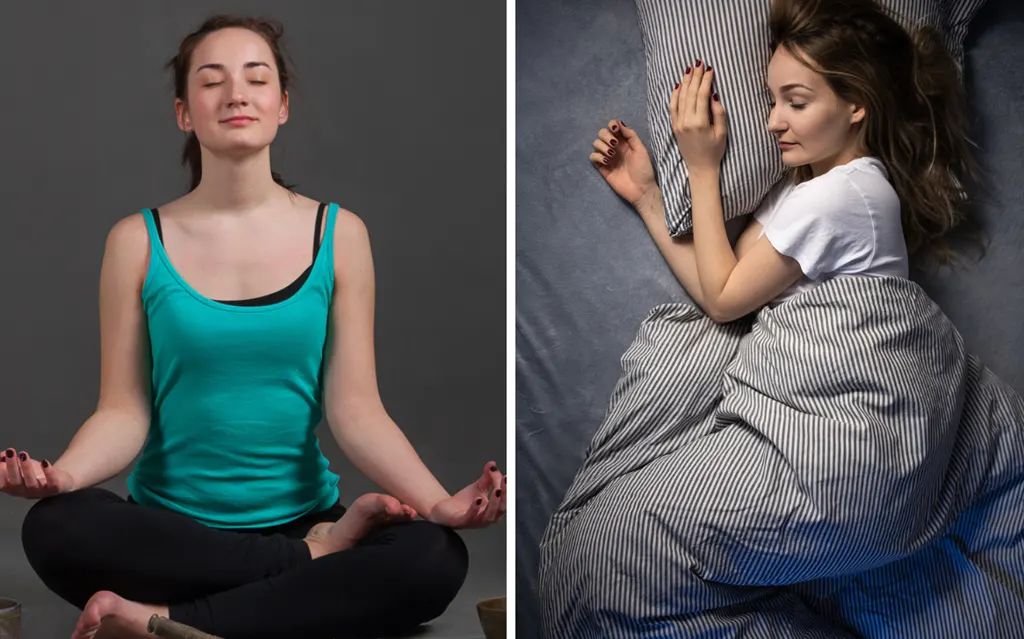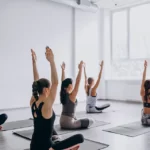Yoga Poses for Better Sleep
If you struggle with falling asleep or experience insomnia, you’re not alone. Many individuals find it difficult to achieve restful sleep, leading to tossing and turning throughout the night. However, there is good news: 3 Yoga Poses For Better Sleep can help regulate your sleep patterns and promote a more peaceful slumber.
Yoga doesn’t have to be a vigorous workout; even gentle and simple practices done at home can have profound effects on your body. By taking a few minutes before bedtime to create a comfortable and calming environment, you can prepare your mind and body for a restful night’s sleep. In addition to yoga postures, incorporating rejuvenating meditation practices can further enhance relaxation.
In this article, we will explore some simple yoga postures that can induce sleep and become part of your bedtime routine. These postures aim to help you say goodbye to the day peacefully and welcome a night of deep, rejuvenating rest. So, let’s dive in and discover the practices that can alleviate insomnia and promote better sleep.
Unlock the secret to banishing insomnia by incorporating these morning-friendly yoga postures into your daily routine. Take a moment to explore these simple yet effective practices that can help you bid farewell to sleepless nights. Let’s dive in and discover the transformative power of these gentle postures in your quest for restful slumber.
1. Standing Forward Bend (Uttanasana) yoga poses for better sleep when you have insomnia
The Standing Forward Bend, also known as Uttanasana, is a highly recommended posture for relieving headaches, and insomnia, and reducing anxiety levels.
How to Do it:
- To perform this pose, start by standing with your feet hip-width apart. As you exhale, slowly fold forward from your hips, allowing your chest to approach the ground.
- You can either touch the floor with your fingertips or bend your arms and hold onto the opposite hand to the opposite elbow. During the practice of Uttanasana, it is beneficial to sway gently from side to side while inhaling.
Benefits
- This movement helps to release tension and promote relaxation in the body. To minimize strain, it is important to bend your knees as much as you need to. With consistent practice, you will gradually experience a decrease in the tension and tightness in your legs.
- The Standing Forward Bend offers a range of benefits beyond its impact on insomnia and headaches. It helps to stretch the hamstrings, calves, and hips, improving flexibility and relieving tension in these areas.
- The pose also encourages blood flow to the brain, promoting mental clarity and calmness. Incorporating Uttanasana into your regular yoga routine can provide a sense of grounding and tranquility, aiding in stress reduction and promoting overall well-being.
Remember to listen to your body, honor its limits, and gradually deepen your practice over time.
2. Plow Pose (Halasana) yoga poses for better sleep when you have insomnia
The Plow Pose, also known as Halasana, is a yoga posture that involves lying on your back and raising your legs above your head, stretching them flat on the ground. During this pose, you can place your hands on your back for support or keep them on the floor.
How to do it?
- To practice the Plow Pose (Halasana), follow these steps:
- Start by lying flat on your back on a yoga mat or a comfortable surface.
- Place your arms alongside your body, palms facing down.
- Inhale deeply and as you exhale, engage your core and lift your legs off the ground, raising them towards the ceiling.
- Use your hands to support your lower back as you lift your hips off the ground, bringing your legs over your head.
- Continue to lift your legs until your toes touch the ground behind your head.
- Adjust your hands on your back for support, or place them on the floor above your head, whichever is more comfortable for you.
- Maintain the pose, with your legs straight and toes pointing upward. Relax your neck and allow your weight to be supported by your shoulders and upper back.
- Breathe deeply and hold the pose for as long as feels comfortable, aiming for 1-5 minutes.
- To release the pose, slowly lower your legs back down, one vertebra at a time, until your entire back is back on the mat.
- Take a moment to rest and relax in Savasana (Corpse Pose) to allow your body to integrate the effects of the posture.
Important tips and considerations: - If you are a beginner or have any neck or back issues, it is recommended to practice this pose under the guidance of a qualified yoga instructor.
- Avoid this pose if you have high blood pressure, a neck injury, or are menstruating.
- Listen to your body and never force yourself into a deeper variation of the pose than what feels comfortable for you.
- Always warm up your body with gentle stretches before attempting more advanced poses like the Plow Pose.
- Remember to focus on your breath throughout the practice, and if you experience any discomfort or pain, gently come out of the pose.
It’s always advisable to consult with a healthcare professional or certified yoga instructor before starting a new yoga practice, especially if you have any pre-existing medical conditions or injuries.
Benefits:
- The Plow Pose helps to reverse the flow of blood in your body, bringing a sense of freshness and rejuvenation. This inversion can have a calming effect on the nervous system, making it beneficial for those struggling with insomnia or difficulty falling asleep. It is recommended to hold the Plow Pose for at least 1-5 minutes to experience its sleep-inducing benefits.
- In addition to promoting better sleep, Halasana stretches and lengthens the spine, shoulders, and back muscles, improving flexibility and relieving tension in these areas. It also stimulates the thyroid and parathyroid glands, which can help regulate metabolism and balance energy levels.
- While practicing the Plow Pose, it is important to listen to your body and avoid any discomfort or strain. If you have any neck or back issues, it is advisable to seek guidance from a qualified yoga instructor before attempting this pose.
Incorporating the Plow Pose into your bedtime routine can help calm the mind, release tension in the body, and prepare you for a restful sleep. As with any yoga practice, consistency, and gradual progress are key, so be patient and gentle with yourself as you explore the benefits of Halasana.
3. Legs Up The Wall Pose or Viparita Karani yoga poses for better sleep when you have insomnia
The Legs Up The Wall Pose, also known as Viparita Karani, is a simple yet highly effective yoga posture that involves lying on your back with your legs extended vertically against a wall. Yoga pose provides numerous benefits for the body and mind.
How to do it?
- To practice this pose, find a clear wall space and sit with one hip against the wall. Gently lie back while swinging your legs up the wall. Your sitting bones should be as close to the wall as comfortable, and your legs should be straight up with your heels resting lightly against the wall. You can place a folded blanket or bolster under your hips for added support if needed.
- Once you are in the pose, allow your arms to rest alongside your body, palms facing up. Close your eyes and focus on deep, mindful breathing. Relax your entire body, allowing any tension or stress to melt away.
Benefits:
- The Legs Up The Wall Pose offers a range of benefits. It helps to improve circulation by facilitating the return of blood from the legs and feet back to the heart. This can relieve swelling and fatigue in the lower extremities. The pose also activates the parasympathetic nervous system, promoting a state of relaxation and reducing anxiety and stress.
- Practicing Viparita Karani regularly can have a calming effect on the mind, making it an excellent choice for those looking to relax and unwind. It can be practiced at any time of the day, but it is particularly beneficial as part of a bedtime routine to prepare the body and mind for sleep.
- Remember to stay in the pose for about 5 minutes to fully experience its benefits. If you feel any discomfort or strain, you can modify the pose by placing a folded blanket or bolster under your lower back or by bending your knees slightly.
As with any yoga practice, it’s important to listen to your body, go at your own pace, and make any necessary adjustments to ensure your comfort and safety. Enjoy the restorative benefits of the Legs Up The Wall Pose and allow yourself to relax and rejuvenate.
Conclusion:
In conclusion, incorporating specific yoga poses like Uttanasana, Halasana, and Viparita Karani into your routine can improve sleep quality and manage insomnia. These poses promote relaxation, release tension, and calm the mind. Practicing them before bedtime can help alleviate anxiety, reduce stress, and prepare the body for sleep. By embracing these gentle and restorative yoga practices, you can experience better sleep and cultivate a sense of well-being. Sweet dreams await on your journey to a more restful slumber through the power of yoga.



















